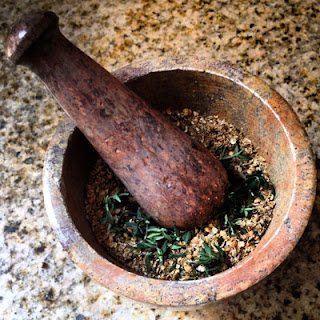One of the first things you learn as an herbalist is to respect the power plants have. Another herbalist and I have often joked that the poisonous plants were the first ones we learned. All joking aside, it is true. These plants can kill or injure the foolish and careless so it is more than right to learn caution and respect from the very start. But what you also realize in those first few lessons is that the green world around you, no matter where you are on the planet outside of perhaps Antarctica, is filled with many, many
useful plants. So many needs - from healing to food to fibers to dyes and more - all answered by plants.
While the arboretum and gardens of Sonnenberg certainly focus on the ornamental aspects of the plant kingdom, the
useful and hence the herbal nature of the place is no less present. An herb,
as defined by the Herb Society of America, is a plant useful in so many ways and not just for seasoning meals in the kitchen. In my strolls through the gardens, greenhouses, and even the wild places of Sonnenberg, I see many beautiful plants but I also see many that can be found in traditional pharmacopoeias or useful for the needs of everyday life.
During your next visit, you are sure to see many such herbs but here a few of the ones you might see:
Aboretum: The linden tree (
Tilia sp., pictured right) is in our arboretum. As with many trees, the wood from this tree is prized and has been used for carving, turning, and musical instruments. But the copious and fragrant flowers provide a wonderful pollen source for bees. As such, linden flower honey is very popular where these trees are grown.
The flowers also are used medicinally for a variety of different needs from lowering blood pressure to improving digestion. In Britain, the linden is call a "lime tree" even though it has no relation to the citrus of the same name. (This is a perfect reason why herbalists do prefer botanical names!) If you see "lime" included in an herbal tea blend, it may be linden flowers instead of the citrus bearing the same name.
Of note, our native Tilia tree, the American basswood (
Tilia americana) was a fiber source for Native Americans. The inner bark or
bast was used to make rope and mats - the tree's name derives from this usage.
Old Fashioned Garden: This garden, featuring flowering and blooming plants hosts a variety of beautiful herbs including: Purple Coneflower (
Echinacea purpurea), Bee Balm (
Monarda sp.), Pleurisy Root (
Asclepias tuberosa), Monkshood (
Aconitum sp.), Peony (
Paeonia spp.), Balloon Flower (
Platycodon grandiflorus), Rose (Rosa spp.) plus a number of others that are in Western, Asian, and even Native American
material medica. The uses of such plants are as varied as the content of this garden itself!
Lawns & Wild Places: I must admit to a special love of herbs in these spaces - especially the lawn "weeds." Weeds they may be in the eyes of some, but desirable and beneficial to others. Walk through an untreated lawn at Sonnenberg or elsewhere and you may see Ground Ivy (
Glechoma hederacea), Dandelion (
Taraxacum officinale), Violets (
Viola spp.), Selfheal (
Prunella vulgaris, pictured right), Plantain (
Plantago Major), and others. So useful were these plants that our European ancestors brought most of those I have just listed to the New World with them. Plantain, for example, was called "
White Man's Foot" by Native peoples for it seemed to follow the "white man" westward across North America.



































